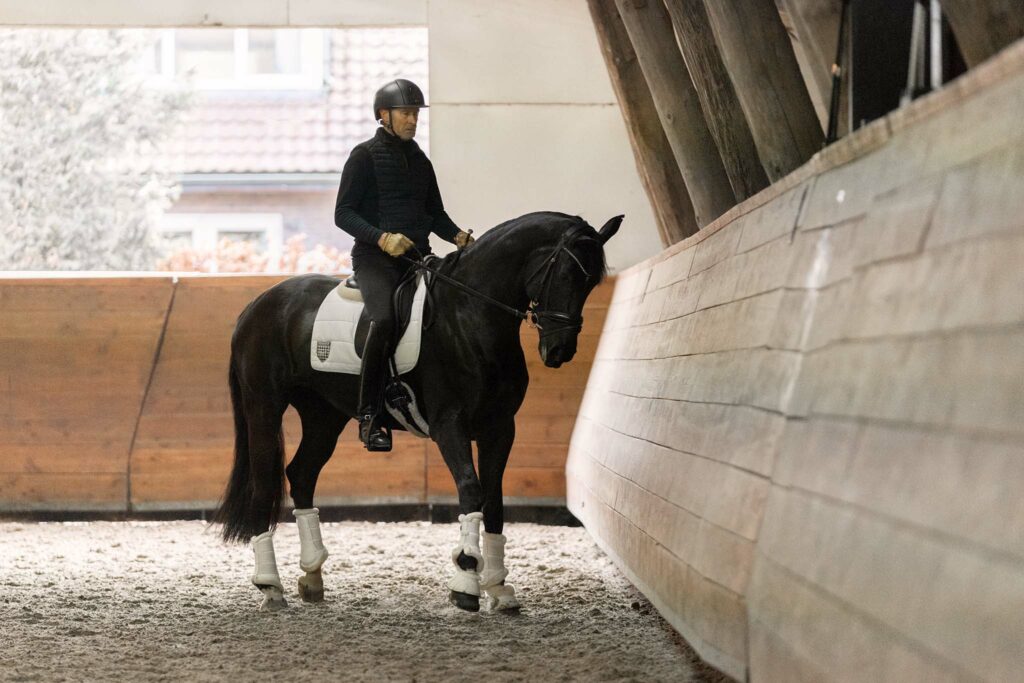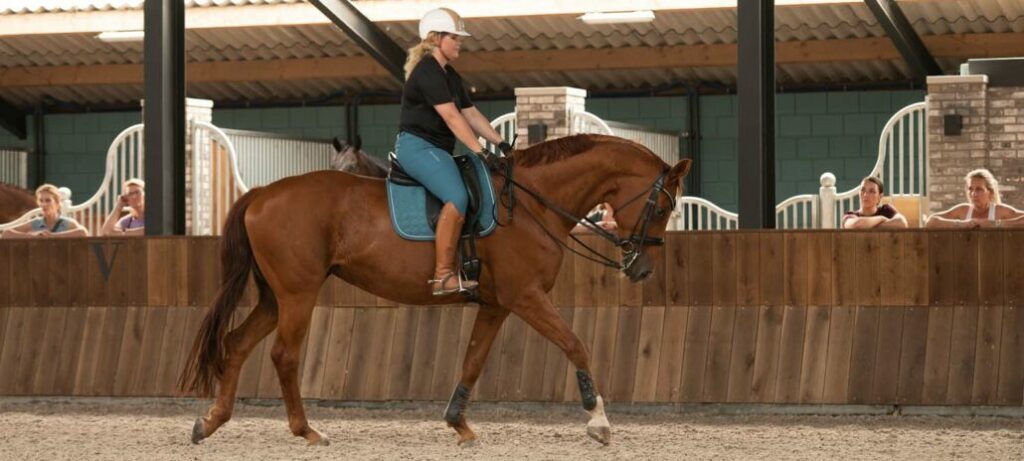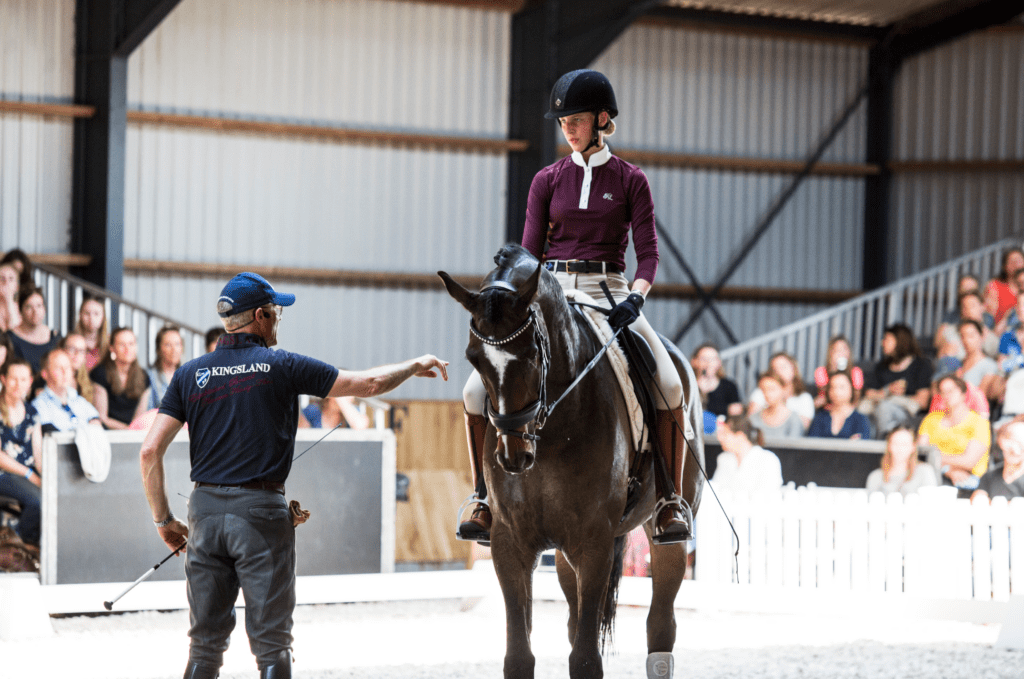Got the idea that your horse is not entirely straight?
That can be right! Because every horse is somehow crooked.
Just like we are left- or right-handed, every horse has a preference for the right or left hand by nature. Therefore, we often speak of left-bent or right-bent horses.
With a right-bent horse, the left side of the horse is strong while the right side of the horse is hollow.
With a left-bent horse, this is the other way around. The right side of the horse is strong while the left side of the horse is hollow.
Normally a horse would want to take on a heavier rein on his strong side. On his hollow side, he’ll find it more difficult to take rein-contact.
Why is straightening your horse so important?
By straightening your horse he will get stronger and less asymmetrical. In addition, the horse will be able to perform the exercises easier.
Besides, it’s very important to have your horse in balance if you want your horse to take on the reins equally on both sides.
And what you shouldn’t underestimate… is that you can prevent a lot of injuries by straightening your horse.
If your horse has more weight on the left or right side, the chance of an injury is much higher.
It can be concluded that straightening is very important. However, do pay attention to the following 3 mistakes that many rider make.
Mistake #1 Straightening your horse without having forward drive
If your horse doesn’t have the right forward drive yet, straightening is impossible.
The forward drive ensures that the spine of your horse is completely connected, from tail till ear.
So make sure your horse has the right relaxation, is forward, and accepts the hand of the rider.
If you accomplished these basic principles, you’ll notice that your horse is already more balanced. From here you can start the exercises to straighten your horse.
Mistake #2 Using flexion to straighten your horse
If you only bend the neck of the horse, this is not considered real bending. Proper bending is preformed over the complete spine of the horse, from tail till ears.
The effect of only bending the neck of the horse is that you create an S-shape in the body.
Oops, what happens then? This often goes together with the tilting of the head.
With this, you will never solve the crookedness of your horse. You’ll only disguise the fact that you don’t have the right bending from your inside leg.
Mistake #3 Trying to lighten your horse with your hands
Some riders try to lighten the heavier rein, on the strong side, by working backward on this rein with their hands. The effect of this is that your horse will only get heavier or it will nod at the third cervical vertebra.
Then you do get the feeling for a little bit that your horse is ‘light’, but is not a true connection with the horse’s mouth.
But how can you fix the crookedness of your horse?
By means of ‘good riding,’ the asymmetry in our horse’s body can be improved quite well.
Did you know that in some cases you can even change the preference side of your horse?
At first, it’s very important that your horse is relaxed, forward, and accepts the hand.
If you have the correct forward drive, you’ll notice that your horse is less unbalanced and feels more straight already.
You can compare it to cycling. If you cycle slower, you swing more than you would when you speed up. It works the same for horses. If you have the power from behind you will less likely go crooked.
In the beginning phase, you shouldn’t disturb your horse’s natural balance too much.
A lot of riders want to straighten their horse when their bodies aren’t ready yet. If you do this, there is more chance of injury.
This means that your horse isn’t entirely straight or doesn’t have the wanted flexion.
However, you can ignore this to some extent… The equal pressure on both reins is more important and you don’t want to disturb the head and neck too much.
If you have ta good connection accomplished, you can move a step further!
Then you want to ride lateral exercises to improve the straightness. Hereby you try to get the horse off his strong side. Thereafter you want to catch that energy on the light (the hollow side) rein.
Pay attention that you mostly practice on the side that benefits your horse.
It’s also smart to realize that straightening the horse is a process that we will never be 100% finished with.
Finally, a tip from Rien
Try to ride your horse on the inner track. This will make your horse have less support from the arena fencing. He is then forced to improve his right-left balance and will be less drawn to the fencing with his outside shoulder.



2 Responses
Very helpful. Thank you. My horse is a 14yr.old Hanoverian.I got him a little time before Covid.During Covid we could not ride in the indoor and in the winter we only had the trails.It was not a bad thing because the horse was a hunter before we got him and he lacked in basic training.
I already rode one very crooked mare like this two months and the result was amazing! She is still difficult, because she has been like this for years, but I can feel after 2 months some flow coming from the hind legs and her back of course much more supple.
And here are coming some questions:
How often I can ask in one training from her sideways, so she is not too much tired, especially the hind leg that she has to cross and put under her body? Because in the beginning I was asking like 70 % of the training and I was afraid not to harm her stifle by so much sideways work. Up to now she is o.k.
And the second question is if she straighten her body, but searching for much more down and stretch position of her neck and body?
Up to now I except this straightness, but I am trying slowly slowly to put some boundaries and slowly to put her on better frame, always checking that I’m not losing the flow from behind and her back, but after 30 seconds I am losing this, I leave her again in more comfort for her stretch position and then again I am trying to put her straight together, is it right?